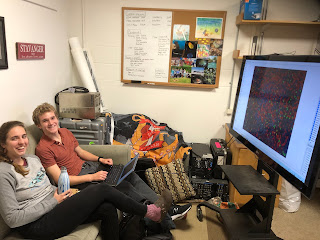New kid on the block

"I'm a new kid on the block Though I may not be Johann Sebastian Bach" - "New Kid (on the Block)" by BNL Whenever a new person sits down at a microscope in the lab, it takes a few minutes for them to get oriented. They have to learn to adjust the eyepieces to fit the width of their face. They take a minute to find the focus knob, then scroll up and down until the specimen comes into clear view. It's a process. Some pteropod larvae (baby snails) in the sample I showed H. I have a new high schooler in the lab, H, thanks to a mentoring program at a local high school. The mentorship in my lab is the first time he's been exposed to tiny animals like larvae, but he's very eager to learn. I showed him how to use the microscope, adjust the eyepieces, change focus, and make himself comfortable. I stood back. "What do you see?" I asked. At this point in the process, the student usually mentions something about copepods. They won't know what the
.jpg)
